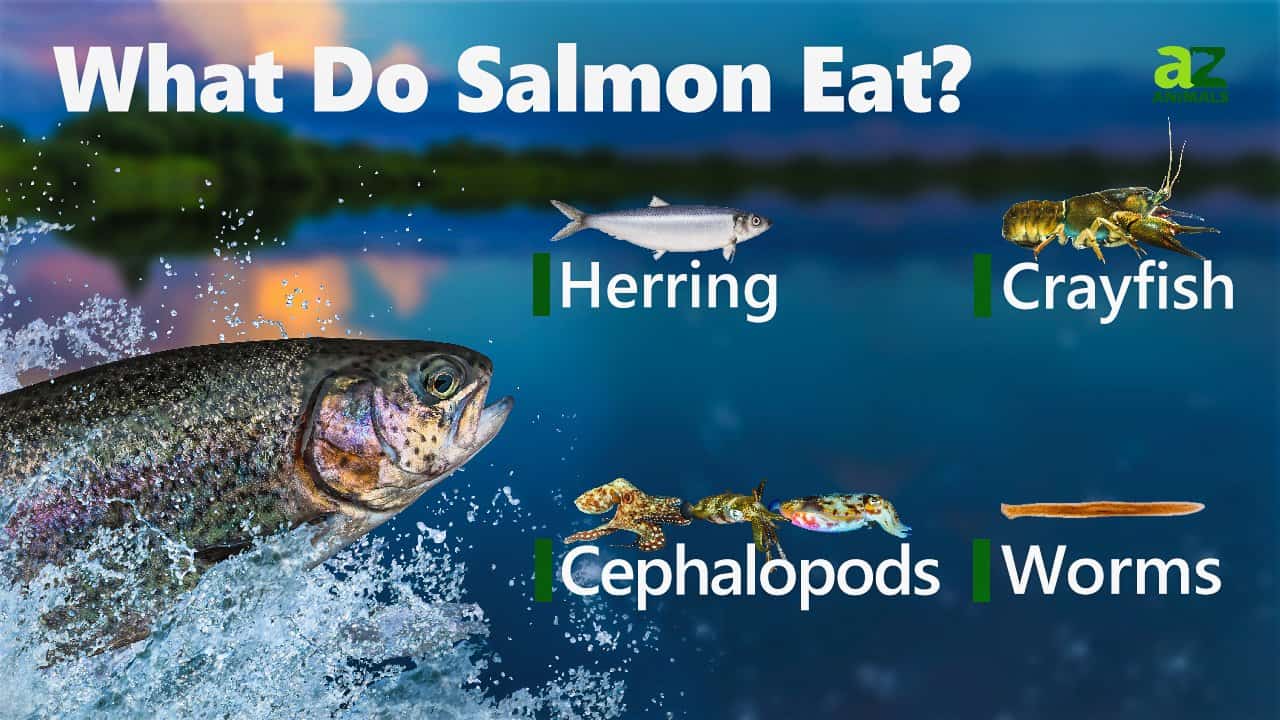Salmon are amazing fish that are popular for both commercial fishing and recreational sport fishing. But have you ever wondered – what do salmon eat?
As carnivorous fish, salmon have a varied diet that changes as they move between freshwater and saltwater habitats during their complex lifecycle. I did deep research into the salmon diet and feeding habits so you don’t have to!
Here’s a comprehensive look at what salmon eat at each stage of their lives
Salmon Fry and Juveniles – Insects, Zooplankton, and Small Crustaceans
After hatching in freshwater streams and rivers, young salmon are called fry. At this stage, they feed on tiny aquatic insects and insect larvae, like mayflies, stoneflies, caddisflies, and midges.
As the fry grow into juveniles or “parr,” they start eating larger foods like zooplankton, amphipods, and other small crustaceans. Parr have camouflaging vertical stripes that help them hide from predators as they feed in shallow water.
Some favorite foods for parr include:
- Scuds
- Amphipods
- Aquatic insect larvae
- Terrestrial insects that fall into the water
- Copepods
- Cladocerans
- Ostracods
Smolts – Transitioning to the Ocean Diet
When juvenile salmon reach a certain size, they go through a physiological change called smoltification to prepare for saltwater. At this “smolt” stage, the diet starts shifting towards foods found in the ocean.
Before migrating downstream, smolts may still eat aquatic and terrestrial insects. But they also start targeting larval fish, small shrimp, marine worms, and other ocean-based prey.
Adult Ocean Phase – Fish, Squid, Plankton, and More
As adult salmon journey out to sea, they become powerful ocean predators. The diverse open ocean diet includes:
- Small fish like herring, sand lance, and capelin
- Large zooplankton like krill
- Squid
- Shrimp
- Crab larvae
- Amphipods
- Copepods
- Fish eggs
Sockeye salmon tend to eat more zooplankton like krill. But kings, chum, and silvers feast on higher-protein fish like herring.
Some salmon even eat other smaller salmon! Overall, their ocean diet provides the energy reserves needed for the strenuous spawning migration.
Spawning Salmon – No Food at All!
Here’s a surprising fact about the salmon diet – when adults return to freshwater to spawn, they stop eating completely!
Spawning salmon do not feed at all for weeks or months. They rely fully on the fat stores built up in the ocean to fuel their upriver migration, maturation, and nest building.
By the end of the exhausting journey, salmon are emaciated and near death. They use their last reserves of energy to spawn, and then die soon after laying and fertilizing the eggs.
The salmon carcasses provide a nutrient boost to the stream ecosystems, supporting the next generation.
Key Takeaways on the Salmon Diet and Feeding
To sum up this deep dive into what salmon eat:
- Young salmon start with insects and zooplankton in freshwater
- The diet shifts to fish and squid in the ocean
- Spawning salmon don’t eat at all and rely on fat reserves
- Habitat and life stage determine the salmon diet
Understanding what salmon eat helps fisheries managers and conservation groups make informed decisions. For example, hatcheries like Cook Inlet Aquaculture Association can use the right feed to raise healthy juveniles.

What’s the difference between Atlantic and Pacific Salmon?
The Atlantic salmon is actually one species within the genus Salmo. There are seven different species of Pacific salmon, which belong to the genus Oncorhynchus.
Atlantic salmon generally dont live long after spawning but are capable of surviving and spawning again. Most Pacific salmon die shortly after spawning, with the exception of steelhead.
How many eggs do Atlantic salmon have?
Generally from 2,500 to 7,000 depending on the size of the female (larger females have more eggs), or about 600–800 eggs per pound of body weight.
Salmon tagged and ready for release.
What Do Salmon Eat? Complete Feeding Guide And Facts
FAQ
What is salmon’s biggest predator?
Animals that prey on adult salmon
Ocean predators include orcas, salmon sharks, and seals. In fact, those populations decline when there are fewer salmon. While marine populations are healthy in Alaska, where other salmon runs struggle, marine life that feeds upon them struggle too.
What do wild caught salmon eat?
Wild salmon primarily eat zooplankton, small crustaceans, and insects in their freshwater habitat. In the ocean, they expand their diet to include smaller fish, shrimp, squid, and even eel.
Do salmon eat their own eggs?
Do salmon eat shrimp?
